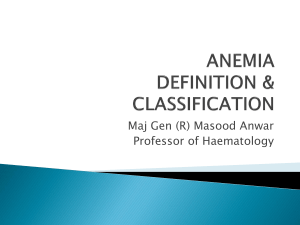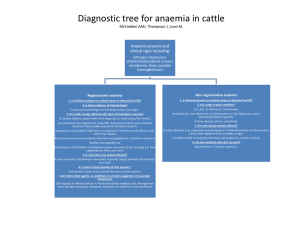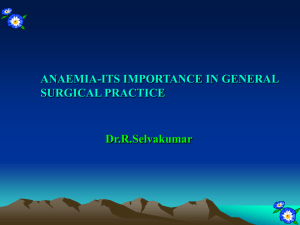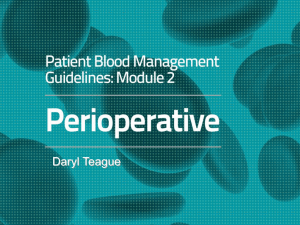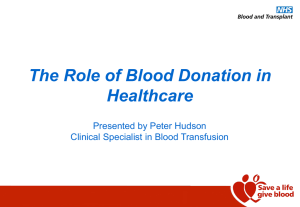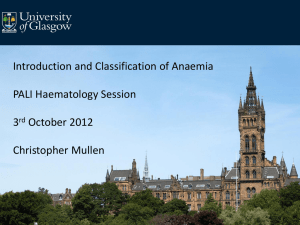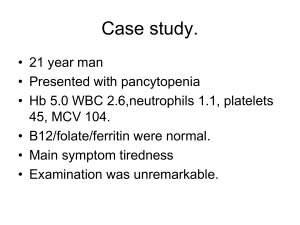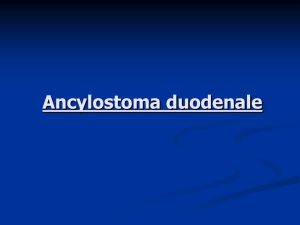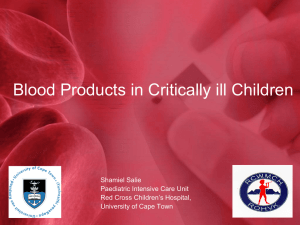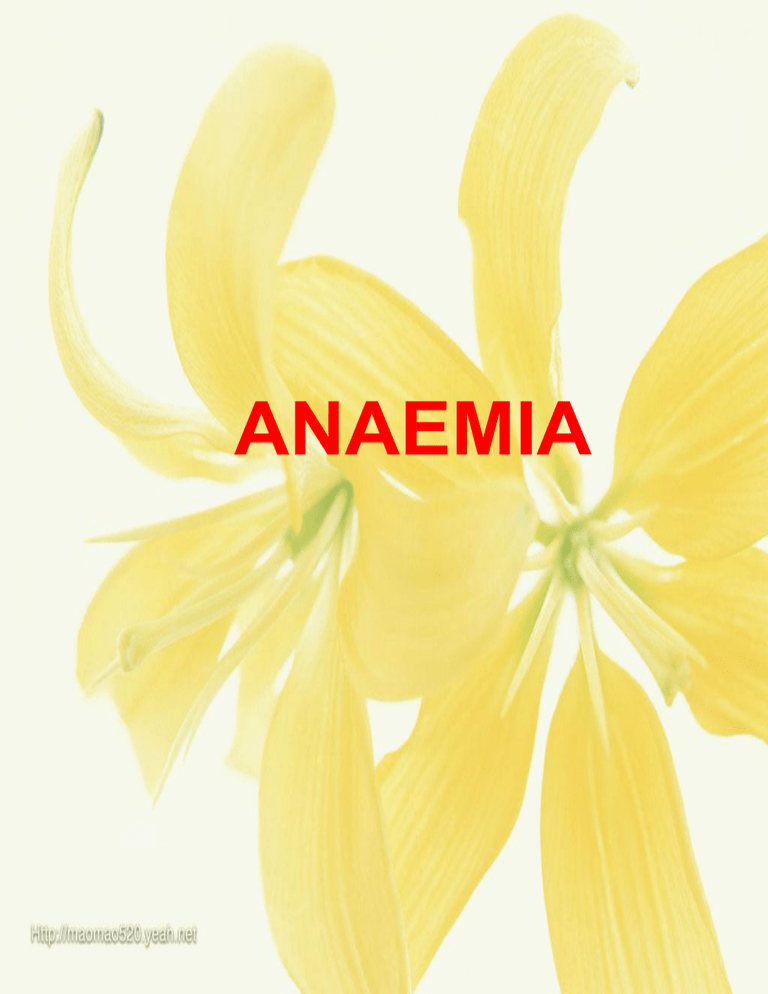
ANAEMIA
Synopsis
1.
2.
3.
•
•
4.
A.
B.
Definition of anaemia.
Causes
of anaemia.
Clinical feature of anaemia.
symptoms
signs
Classification of anaemia.
Iron deficiency anaemia
Megaloblastic anaemia or
macrocytic anaemia
C. Parnicious anaemia or
addisonian anaemia.
D. Aplastic anaemia.
E. Haemolytic anaemia.
• Sickle cell anaemia
• Thalesemia or cooleys
anaemia.
5.
Investigation of anaemia
6.
management of anaemia
7.
Case Record
Definaton:-
Anaemia is defined
as a state in which blood
haemoglobin level is below the
normal range for the patients age
, sex and altitude of resistance.
Normal Hb. Level –
In males - 13 -18gm%
In females - 11-5 -16.5 gm%
Children10-12 years – 11.5- 14
gm%
Childern 1year – 11.0 -13.0 gm%
Childern 3months- 9.5 -12.5gm%
Infants13.6 – 19.6gm%
Blood cell
Causes of Anaemia:--1)Due to Inadequate
production of normal RBC
Deficiency – of Iron &vit B12
folate.
Endocrine deficiency–
hypothyrodisum,
hypopituitarism
hypoadrenalism, hypogonadism,
Reduced erythropoietin
Marrow failure- Hypoplastic,
aplastic anaemia Marrow
invasion - Leukemia, secondary
CA
Maldevelopment - Sideroblastic
A, Haemoglobinopathies.
Toxic Factors- Renal failure,
hepatic failure drugs.
2) Due to excessive distruction
of red cells (haemolytic).
a) congenital/ Genetic – Hb. Or
enzyme deficiency.
b)Aquired - infections e.g. malaria
3)Due to excessive blood loss –
a) accute blood loss –e.g. trauma,
post partum bleading.
b)Chronic blood loss- e.g. peptic
ulcers, worm infection,
menorrhagia.
Clinical feature of anaemia :1.Symptoms :Weakness
Irritability, lack of concentration
sleep
disturbances.
Dizziness, headache, syncope,
vertigo, lassitude.
Throbing in head, ears.
Fatigueness, paraesthesia in
finger, toes
Anorexia nausia, indigestion
bowel disturbances.
Dyspnoea on Exertion.
Palpitation angina, symptoms of
cardiac failure.
Amenorrhoea, polymernorrhoea.
2. Signs :Pallor of skin, oral mucosa
mambrane, tongue, nail beds,
palpebral conjunctiva.
Oedema.
Tachycardia ,wide pulse pressure .
Koilonychia Brittleness amd
longitudinal ridging on nails.
Sign of cadiac failure.
Murmure.
SYMPTOMS
Abdomen – spleenomegaly.
Classification of anaemia :-------1. Based on the aetiopathology.
2. Based on the morphology of cell.
1. Morphologiical classification
Macrocytic or megoloblastic
Anaemia.
Microcytic anaemia – Mcv more
than 100 fl.
Normocytic Normochromic anaemia
or Aplastic Anaemia.
Hypochromic microcytic anaemia or
IDA –MCV less than 78fl.
2. Aetiopathological
classification
I. Dyshaemopoietic – These are
due to a deficiency in one of
essential factors for the
synthesis off Hb. Or. Normal
RBC
For e.g. :- Deficiency of Vit.
B12, Deficiency of iron, of
thyroxin, of vit.c.
II. Haemolysis or H/g.
.
Due to excessive distruction of
RBC.
Congenital e. g. sickle cell or
thalesemia.
Aquired e.g. infection
B.Post morrhagic anaemia.
For e.g. – Bleading piles ,
malena,peptic ulcers,
menorrhagia.
c. Due to mismatchod blood
transfusion and RH
incompatibility
Iron deficiency Anaemia:-------Iron deficiency anaemia is the
commonest form of anaemia. It is
also called as hypochromic
microcytic anaemia because in
this type of anaemia chromatin
material is in the less amount
and the size of the RBC small.
Cause :------Increased Blood loss
Increased requirement
Inadequate Dietary intake
Decreased Absorption
C/F :---Angular Stomatitis
Glossitis (Bald tongue)
Nails – thin ,
fragile,platynychia, koilonychia.
PICA- indicates a craving for
strange items like coal,
earth,tomatoes, starch, ice, rice.
PLUMMER VINSON
SYNDROME or Sideropenic
Dysphagia or Patterson kelly
syndrome :--- This is occurs in
long standing anaemia and
characterised by I.D.A.,
dysphagia, koilonychia and
glossitis.
Megaloblastic anaemia
Megaloblastic anaemia is a disorder
caused by the impaired DNA synthesis
and is charecterized by distnictive
abnormality in the haemopoitic
precursors cells in bone marrow in
which the nucleous maturation is
delayed as compare to that of
cytoplasm. Normally the cell division
occurs and cytoplasm grow and hence
the nucleated precursor red cells grows
enormously which are abnormal both in
morphology and function. Hence these
large cells are called megaloblasts and
the RBC formed and released in
circulation from these megaloblasts are
also abnormal with increased size
hence C/d macrocytes the impairment
of the DNA is caused due to the
defciency of vit. B12 or folic acid.
C/F:--------All c/f of anaemia.
glossitis, Angular cheilosiss.
jaundice – Due to
intramedullary breakdown of
Hb.
Neurological manifestation.
e.g.- degeneration of spinal
cord.
Numbness.
Sterility.
Parnicious anaemia :----- This is
a megaloblastic macrocytic
anaemia resulting from a failure
of secretion of the intrinsic
factor by the stomach. In the
abscence of intrinsic factor
dietary vit. B12 is not absorbed
& results in vit B12 deficiency.
C/F:---
All c/f of anaemia.
C/F of megaloblastic anaemia.
Aplastic anaemia :------ It is defined
as a condition of inhibition of the
process of haemopiosis in which an
acelluar or markedly in pancytopaenia
i.e. anaemia granulocytopaenia,
thrombocytopaenia.
C/F:--------------- Pancytopaenia.
Anaemia .
Granulocytopaenia – leads to
infections.
Thrombocytopaenia – leads to
haemorrhage.
Haemolytic anaemia :-Haemolytic anaemia mean a
premature distruction and
increased rate of the distruction of
the RBC’s.
Normal life span of RBC’s = 120
days
C/F:---1 All c/f of anaemia.
2 H/O :Jaundice.
Black urine with haemoglobinuria.
Urine is normal in colour on passing but on standing
black.
Cholilithiasis
Spleenic pain.
Infections.
3. Physical findings :Signs of anaemia.
Jaundice.
Spleenomegaly.
Chronic leg ulcers.
Skeleton hypertrophy – enlargement
of the maxillary bones & frontal.
Signs of cholilithiasis.
Sickle cells anaemia :---- This
is a haemolytic of a intrinsic type due
to the haemoglobinopathies in
structure, of the chain.
Sickle cell anaemia results from an
abnormal haemoglobin known as
haemoglobin S(Hb-s) or sickle cell
haemoglobin.
Clinical features:---- 1. In children
Clinical manifetations are absent in the
first 6 months of life because high. Hb f level
protects the red cell sicllings.
Infections are common.
HAND foot syndrome – micro infection of
carpal and tarsal bones.
Spleenic sequestration syndrome sudden pooling of blood within the spleen
resulting in spleenomegaly, hypovolaemia
sock.
Spleenomegaly present throughout the
early childhood But later spleenic atrophy.
By about &year of age, spleen is no longer
palpable.
2. In adults :--Clinical feature of anaemia.
C/F of haemolytic anaemia.
INFARCTION CRISIS :--Occlusion of microvascular circulation by
the sickle cells leading to tissue ischaemic
and infarction, charactrised by .
Sudden attack of bone & ab. Pain.
Spleenic infarctioon.
Cerebral infarction – hemiplegia.
Pulmonary infarction – accute chest
syndrome.
Renal infection - haematuria .
Retinal infection – loss of vision
Aplastic crisis :-HAEMOLYTIC CRISIS :-- Hb.deacreases And
hepatospleenomegaly.
Thalesemia / cooleys’s
anaemia
This is a haemolytic anaemia of a
intrinsic type due to the
haemoglobinopathies in synthesis of
Hb.
The fundamental defect in the
thalessemia is a reduction or
absence of synthesis of one of the
globin chains.
Clinical features :----- General c/f of
anaemia
Skeleton deformities – frontal
bossing cheek & low bone
protrusion – pathological fractue of
long bone.
Progressive hepatospleenomegaly.
Investigation : total blood count – Hb, Tand
D, DLC,
E.S.R.,platelate,reticulocyte
count.
Coombs test (for investigation
of Hb).
Hb electrophoresis .
B.T. ,C.T.
Ab. Test .
Management :- accor. To cause
and severity.
correction of dietary deficiency
administration of specific
lacking substances.
Removal of toxic chemical
agent or drugs.
T/t of cause .
B.T.

